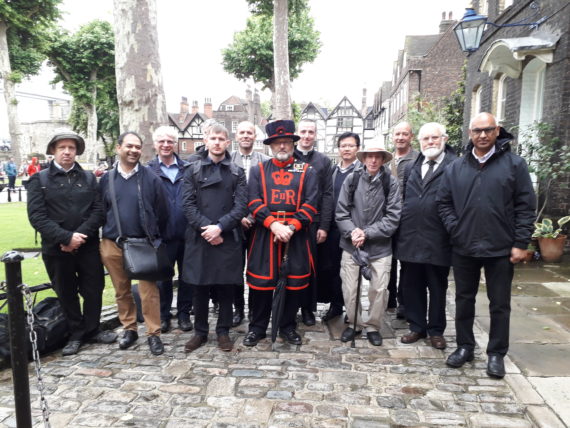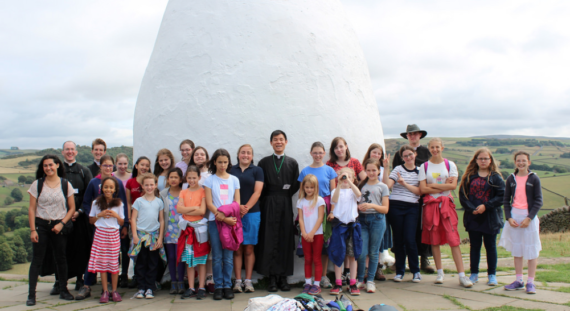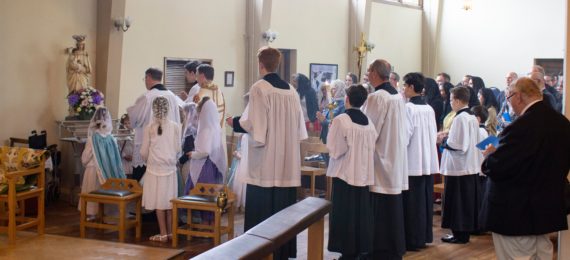Amazing Ordinations pictures
11 FSSP priests ordained this year:
and more here: https://photos.app.goo.gl/N3cKndDqYfyVxc2J8.
Video of Nebraska ordinations last month here:https://vimeo.com/337119028
Deo gratias!
11 FSSP priests ordained this year:
Juventutem week-end at Douai Abbey: more spaces available:
Becoming Saints in an Anti-Christian World
Douai Abbey, Berks, 19-21 July 2019
Click here to see our schedule.



Convivial Weekend for young adults 18-35 with doctrinal and spiritual talks, debates, Holy Mass, Confessions and Eucharistic Adoration.
All meals provided, limited places available
Shared room in the cottage: £110*
Shared room (Guest House/en-suite): £125 (FEW PLACES LEFT)
Single room (Guest House/en-suite): £150 (FEW PLACES LEFT)
50% deposit required for reservation
*Student discount available
Led by Fr Armand de Malleray, FSSP & Fr Patrick O’Donohue, FSSP
Organised by Juventutem London & FSSP England
For more info or to reserve a place, please contact: juventutemldn@gmail.com
Juventutem London videos here: https://www.facebook.com/pg/londonjuventutem/videos/
Deo gratias for a splendid fourth annual Corpus Christi procession on the external solemnity of the feast, last Sunday 23rd June 2019. People came from far and wide to walk by Our Lord and sing, giving this beautiful witness of the Eucharistic truth. See all pictures here.

Thank you to our servers, singers, clergy, canopy bearers, stewards, flower petals gatherers, to our talented photographer J.K., and worshippers in general. The procession went from St Mary’s Church Shrine to St Alban’s, the mother church of Warrington.
Shrine Rector Fr de Malleray, FSSP carried the monstrance, assisted by Fr Loewenstein FSSP and Fr Andrew Jolly. Fr Dave Heywood PP led the procession with permanent deacons from the deanery. At the kind invitation of Warrington Dean Canon Christopher Cuningham, Fr Heywood gave the final Benediction at St Alban’s.
Next year, we envisage starting the procession immediately following the end of our 11:00am Sunday Mass, to make it easier for people already present to attend.
‘Ecce panis angelorum factus cibus viatorum.’
———————-
[To learn more about the Holy Eucharist, visit https://www.lumenfidei.ie/product/ego-eimi-it-is-i/ ]

Click here to see pictures from the Reading Men’s Group recent visit to the Cell of St Thomas More at the Tower of London!
Now available online: click on picture below to open the pdf.
[Preferably display on your screen as double page.]
In this issue:
Editorial: Blasé, Blazing, Blessed
Fr de Malleray discusses the supernatural meaning of the fire at Notre-Dame for Europe and Christianity
Interview with an Ex-Mason
A courageous man shares his past experience as a freemason and why he left.
Forthcoming Events
Our summer camps and youth apostolates, for your diaries.
Fr John Gerard: The Jesuit Pimpernel
Fr Loewenstein reviews the autobiography of a humorous and inventive English missionary under Penal Times.
Death Penalty and Church Teaching
Dr Cyrille Dounot explains the teaching of the Church and Fathers on this delicate question.
Young Men Travel To Amsterdam And Beyond
Fr Armand de Malleray reviews The Spirit and the Flesh, a recently published conversion narrative by T. J. Dias.
The Case of Pope Liberius and St Athanasius
Dr Seth Phipps examines the evidence regarding the good standing of the heroic Patriarch of Alexandria.
Support Our Apostolate
We rely on your generosity to help us continue our service to souls in the British Isles, and even extend it.
Share this link with your relatives and friends: a costless way of evangelising!
Homily to young adults and professionals on the 15th anniversary of Juventutem, Friday 24th May 2019, Feast of Our Lady Help of Christians, St Mary Moorfields, London, UK, by Fr Armand de Malleray, FSSP, General Chaplain to the Juventutem International Federation (cf www.juventutem.org). See typed summary below video screen – click on picture or link to start video.
https://www.facebook.com/londonjuventutem/videos/2205598292863667/
On the 15th anniversary of the Juventutem movement, on the feast of Our Lady Help of Christians, Fr De Malleray, FSSP, gives a sermon on the sanctification of youth. He begins with an overview of Juventutem, which gets its name from the psalm “Judica Me”, and was created with the purpose of helping young Catholics become saints through the Roman traditions of the Church.
Fr De Malleray reminds us that sanctity is our most important goal. But we can often be persuaded that it’s far too ambitious, that sainthood is only reserved for others. Nevertheless, he says, every human being is called to become a saint, and they are called right now in this moment. Indeed, such a calling will not be easy. The youth of today are beset by media, celebrities, allured into false paradises, while the teaching of the Church is out of focus. Meanwhile, the Magesterium is losing some of its precision and determination. All of this makes it objectively more difficult for us to become saints. Yet we must remember: “where sin abounds, grace over-abounds”.
Fr De Malleray asks: “do you want to be a saint?”. It is the will of God and He has given us the means, if we will only dispose ourselves to them. What stands in the way? The frailty of our human condition, and the voice whispering in our ear that sainthood is beyond our reach. Difficult though these are, we should have some perspective. The youth of the historical church had it far tougher than those of today. We still enjoy freedom and we should make use of it to live a sacramental life. The sacrifice of the mass; confession; daily meditation; devotions – such as those to Our Lady – all of these enable us to draw closer to Our Blessed Lord.
He reflects on the emblem for Juventutem. It is a monstrance, and signifies the importance of deepening our Eucharistic faith. Fr De Malleray identifies the Traditional Latin Mass as the best means from which our sancrification must be drawn. This liturgy, which most eloquently expresses the salvific truth of Christian revelation, is unique. There has not been found a rite more adequate, fitting and fruitful than this. Countless saints, down the generations, have been nourished in their love for the Holy Eucharist through the words and gestures of what is called the Extraordinary Form of the Roman Rite.
Fr De Malleray concludes: “Do you want to become saints?” It is possible. There is only one problem. Sin. But this problem can be addressed if we are willing. If we cooperate with the grace of God, through the Sacrifice of the Mass, and welcome Our Lord into our hearts. Then, having received the truth, it is fitting to share it with others. We should tell our friends of this saving truth. God will help us in our mission. His grace has been made available. All it needs is our co-operation, of self-surrender in our daily lives. Fr De Malleray then invites the faithful, to give the Lord a blank cheque that He might dispose of our talents in the way that He knows best, in order to be His apostles, and facilitate the conversion of London, and England back to Our Blessed Lord and Our Blessed Lady.
“This we ask through the intercession of all the young canonised saints and Our Lady Help of Christians”

Click here to see photographs of last year!
Thank God for a third UK applicant admitted at our international seminary in America.
Please pray for any hurdle to be overcome for Harry, Conan and Tom to begin formation for the sacred prieshood next September at Our Lady of Guadalupe Seminary.
There are various causes explaining why these three brave men applied, and got admitted. But surely, your prayers for priestly vocations are an important factor, in response to the Lord’s command: “The harvest is abundant but the labourers are few; so ask the master of the harvest to send out labourers for his harvest” (Mt 9:38).
Congratulations to Monica from Liverpool and Matteo from West Sussex who will be enrolled in our international prayer network, the Confraternity of St Peter, next 9th June, on Whitsunday.
Like them, make your prayer for vocations more efficient through https://www.fssp.org/…/help-us/confraternity-of-saint-peter/, and have 460 FSSP clerics + 6,600 Confraternity members include you in their daily prayers.
————————————
Confraternity of Saint Peter FAQ’s
Can I still join the Confraternity if…
1) If I can’t travel easily and I would not have the time to attend events with the Confraternity?
– Yes, you may join. Provided you say the daily decade and Prayer, and have the Mass offered once a year by any priest in good standing, you are not required to do anything more, even on the day of your enrolment.
2) If I do not intend to be part of the Priestly Fraternity of St Peter?
– Yes, you may join. The Confraternity of St Peter (CSP) is formally distinct from the Priestly Fraternity of St Peter (FSSP). Any Catholic can join the former; but only priests and future priests can join the latter. Confraternity members retain full liberty and can decide to leave at any time.
3) If I already have spiritual commitments?
– Yes, you may join. For instance, if you are already committed to praying one decade of the rosary daily, you can apply it to the Confraternity’s intentions, added to your other intentions. If those were meant to exclude any other, you simply say a further decade.
4) If I normally attend the Ordinary Form of the Roman Rite, not the Extraordinary Form.
– Yes, you may join. Your prayers for priestly vocations and ministry as a committed Catholic are always valued.
5) If I want to pray for vocations not exclusively to the Priestly Fraternity of St Peter?
– Yes, you may join. As a member of the Confraternity, you intend your prayer to benefit principally our seminarians and priests, but you may include others at your discretion.
6) If I am a seminarian / deacon / priest / bishop / religious / sister?
– Yes, you may join. The Confraternity is not for lay persons only. Any clerics and consecrated persons in good standing are welcome.
7) If I am not able to give any money?
– Yes, you may join. Your commitment is purely spiritual, and we do not expect you to contribute financially. Financial support to the formation of our seminarians and to the ministry of our priests is gratefully received, irrespective of Confraternity membership.
8) If I can’t conveniently recite the daily decade and Prayer in Latin, nor have the yearly Mass offered in the Extraordinary Form?
– Yes, you may join. You may say the decade in your preferred language and use any approved translation of the Prayer. While it is fitting to have the yearly Mass offered according to the Extraordinary Form of the Roman rite, any other rite authorised by the Catholic Church may be used as an alternative.
https://www.fssp.org/…/help-us/confraternity-of-saint-peter/
Click here to view the entire photo album!

After their successful annual Conference at St George’s Cathedral in London last 4th May (nearly 150 attended).
Great articles in this issue on Conversion, Islam, Education, Literature, Faith, by Cardinal Sarah, Gabriele Kuby, Fr Linus Clovis, Fr Armand de Malleray and more.
Click here or on cover picture below to open the online magazine.